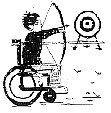All children should be involved in sport at school, right from the start.
Involvement in sport will:
- Improve fitness
- Improve balance and co-ordination
- Give opportunity for social interaction
- Increase self-esteem
And its fun!
- 1. Physical ability:
- Does the child use a wheelchair, or does the child use aids to walk? Can the child run? At times, a child who can walk but with some difficulty, is more difficult to cater for than one who uses a wheelchair. If the child has a wheelchair but seldom uses it, perhaps a PE or sports session is the time to use it.
- Ability to transfer in and out of wheelchair.
- Mobility on the floor.
- Fitness/endurance.
- 2. Motivation.
- 3. Upper limb strength and co-ordination.
- 4. Eye-hand co-ordination, visual-perceptual problems, etc.
- 5. Cognitive level (understanding of rules, remembering commands, etc.)
Most children can be involved in a wide variety of physical games/sports, with or without modification.
As a general rule, assume a child can join in the activity, then try to work out what modifications may be needed, if any.
Modifications may take the form of:
- (i) Modifying the whole activity slightly.
- (ii) Modifying the rules for the child.
- (iii) Modifying equipment used, etc.
Ask the child what he/she can do! A child often has excellent ideas on how he/she can participate as fully as possible.
Ask the rest of the class! Other children are often very inventive. Also, they will usually have more understanding of the disability, and accept modifications to an activity more readily, if they have been involved in the process.
Remember, the game must be challenging and rewarding for all the players. Don't make it too easy for the rest of the group!
While children should be fully involved with the rest of the class in all sports or activities wherever possible, this is not always possible or practical.
It may be desirable at some time to give a child an alternate program, perhaps with just a few other children, to practice specific skills, so that he/she can then rejoin the group with an improved skill level. Some examples may be simple throwing and catching, or dribbling and goal-shooting in basketball.
- 1. Running in softball/cricket etc.
Allow the child to cover only half the distance (reach a middle point) to be safe. They can finish the distance at their own pace. - 2. Allow a child who can stand and walk, but with poor balance, to sit or lean against a solid object, for striking activities.
- 3. Allow use of a batting tee, in striking activities.
- 4. If needed, a smaller or lighter bat may be appropriate. A larger ball will simplify catching/striking activities.
- 5. In team ball games, e.g. captain ball, have one less child on the team, to allow for the extra time the child with spina bifida may take.
- 6. Use of a multi-coloured ball with help a child who has difficulty with visual tracking.
- 7. A bounced ball is easier to follow and therefore catch, than a ball which is thrown direct.
- 8. In running races, a disabled child should not finish last every time. Allow a child to run (or wheel) with the rest of the group, but with an earlier start or a shorter distance to cover. (The finish line should be the same). In this way, the child should usually finish in the main group.
- 9. Use the "buddy system". The "buddy" - often it is a good idea for the "Buddy" to be a different person each time - can help as needed. Sometimes it may be someone to hold the hand of a runner with poor balance.
- 10. Rule changes may be made to simplify any game. The rules may be different for different children.
- 11. Prevent the more able players dominating play totally by restricting their role e.g. the "no-return - pass".
- 12. Restrict certain players to a specific position on court.
- 13. "Safe-ball" rule:
In passing games, defending players may not infringe within 2 metres of the disabled child with the ball. Time and distance limits apply as usual. - 14. In net games, keep the net height standard, but give some individual practice at clearing the net.
These may sometimes need to be given individually to a child with spina bifida, to ensure they've been understood.
2. Highly inflated tyres make a wheelchair much easier to push/manoeuvre.
3. A hard, smooth surface is much easier to wheel on than a soft surface. If there is someone in a wheelchair in the group, have you chosen the best possible location for the activity? If the only option is a rough, grassed area, the child in a wheelchair may need to be pushed.
2. Aussie Sports
"Activities Manual for Children with Disabilities."
3. Aussie Sports
"Willing and Able" PE and Sport for Young People with Disabilities".
4. "The Child with Spina Bifida and Sport" available from this Association.
5. Sporting Wheelies - Phone (07) 3252 5242
They cater for anyone with a physical disability, not just those in wheelchairs.
They can offer:
- Information on wheelchair equivalents for many events
- Information and advice on how to adapt a PE or sports program
- Sometimes, a school visit can be arranged, to give further assistance with a modified program. This depends on the area.

